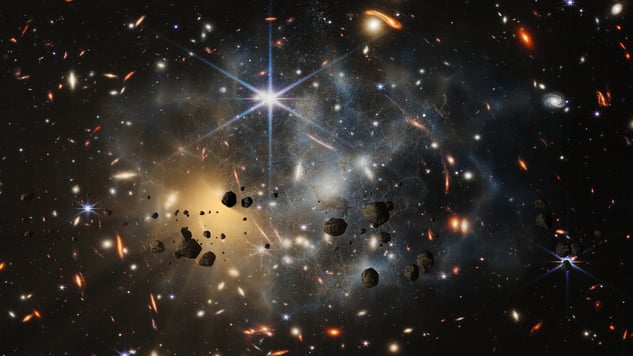Modern-day space exploration is flourishing, as new technological advances offer a look into parts of space scientists have yet to see. One of the most recent advancements — the James Webb Telescope — took nearly 30 years and $10 billion to build and was officially launched in December 2021. Images it recently downloaded include never-before-seen footage of what may be the two most distant galaxies ever discovered. The Webb telescope is expected to show footage of planets, stars, black holes, and more that existed 100-250 million years after the Big Bang at distances of hundreds of light years from earth.
Scientists are eager to learn what answers the Webb telescope can provide about how our universe came to be. Unfortunately, while there are many predictions and theories on this subject, factual evidence does not exist. However, the James Webb Telescope will help scientists get closer to evidence than ever before, and more discoveries are yet to come. The photo below shows one of the first images captured by NASA, showing thousands of galaxies using the telescope.
Webb Telescope Structure
Twenty-foot fold-out photovoltaic solar panel arrays provide the telescope with 2,000 W of electrical power. The Webb telescope has several key instruments, including:
- Mid-Infrared Instrument (MIRI) uses a camera and spectrograph to detect light from distant objects the human eye cannot see
- Optical Telescope Element (OTE) consists of a backplane and a set of beryllium mirrors covered in a thin layer of gold, whose purpose is to reflect infrared light
- Integrated Science Instrument Module (ISIM), which contains cameras and instruments
- Near Infrared Camera (NIRCam), which can detect light from some of the earliest stars and galaxies
- Near InfraRed Spectrograph (NIRSpec) disperses light into a spectrum that can be analyzed for information about the chemical composition, temperature, and mass
The spacecraft bus (another part of the Webb Telescope structure) is the home of subsystems such as thermal control, electrical power, communication, propulsion, altitude, and command and data handling. It is important to note that a sun shield is needed to keep the heat away from the OTE and ISIM because these instruments must remain very cold.
All of these systems require reliable electrical connector solutions that meet space-application requirements.
Material Constraints for the James Webb Telescope
Materials used in the Webb telescope must be highly reliable in harsh environments, including extremely cold temperatures. For example, light-sensitive sensors in the MIRI operate below 7 K. Reliability, in general, is vital because nothing can be done if something breaks a million miles away in space. For such reasons, materials chosen for use in the Webb Telescope were engineered to last up to 10 years due to harsh conditions. Materials must also meet strict outgassing requirements.
There are even more constraints when it comes to electrical connectors for applications similar to the James Webb Telescope. These can include EMI shielding, lightweight, corrosion resistance, and resistance to shock, vibration, and impact.
Connector Solutions for Space Applications.png?width=237&height=174&name=ITT%20Cannon%20Combo%20D%20and%2024308_DSC1443%20(2).png)
Many space-grade connector solutions are available today that are ideal for a variety of applications used in space. For example, PEI-Genesis carries D-Subminiature connectors from ITT Cannon. As an extremely versatile solution, these D-Subs fit a wide range of applications and come in an array of styles, sizes, configurations, and accessories. More specifically, these interconnects fit satellites, launchers, exploration vehicles, payloads, and space hotels.
PEI-Genesis also carries the MACH-D Series from Positronic, offering high-performance space-grade connector solutions for military and spaceflight applications. MACH-D also provides outstanding EMI shielding protection and electromagnetic compatibility while protecting against shock, vibration, and impact. Read below for more information from one of our PEI experts, Todd Maddox.
PEI-Genesis also provides a full range of Amphenol D38999 Circular Mil-Spec Connectors, including the JT (Series II), LJT (Series I), and TV (Series III). These circular connectors are ideal for space applications with their rugged, environmentally sealed design. In fact, they provide highly reliable performance in even the harshest of environments.
The Conesys D38999 Series I, II, and III are widely used in the aerospace industry because they are durable, corrosion resistant, lightweight, and fully qualified to MIL-DTL-38999 Standards. They also offer shock resistance and EMI/RFI shielding.
PEI-Genesis: Your Space-Grade Connector Partner
At PEI-Genesis, we understand the demands of space applications, which is why we stay on top of the latest advancements in space travel and exploration and offer a wide range of space grade connector solutions. PEI-Genesis can successfully outgas a connector within hours at our manufacturing facilities so that they meet the necessary standards.











